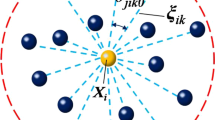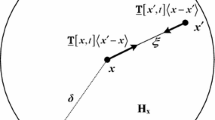Abstract
The stress-based failure criterion is implemented into the non-ordinary state-based peridynamic model. The non-ordinary state-based peridynamic model is developed to simulate the initiation, propagation and coalescence process of cracks subjected to quasi-static and dynamic loads. Three-point-bending tests with a notch offset from the center of the beam are numerically conducted under quasi-static loads. The mode I fracture toughness of Kimachi sandstone has also been evaluated using the non-ordinary state-based peridynamic model by semi-circular bend. Moreover, the proposed method is applied to investigate the effects of arrays of cracks on propagation and coalescence process of multiple cracks subjected to dynamic loads. The numerical results are in good agreement with the previous experimental and numerical results. It is concluded that the non-ordinary state-based peridynamic model is able to analyze fracture problems.























Similar content being viewed by others
References
Aifantis EC (1984) On the microstructural origin of certain inelastic models. J Eng Mater-T ASME 106:326–330
Atluri SN, Zhu T (1998) A new meshless local Petrov–Galerking method (MLPG) approach in computational mechanics. Comput Mech 22:117–127
Belytschko T, Black T (1999) Elastic crack growth in finite elements with minimal remeshing. Int J Numer Methods Eng 45:601–620
Belytschko T, Krongauz Y, Organ D et al (1996) Meshless method: an overview and recent developments. Comput Methods Appl Mech Eng 139:3–47
Belytschko T, Lu YY, Gu L (1994) Element-free Galerkin methods. Int J Numer Methods Eng 37:229–256
Bobaru F, Silling SA (2004) Peridynamic 3D problems of nanofiber networks and carbon nanotube-reinforced composites. In: Materials and design: proceedings of numiform. American Institute of Physics, pp 1565–1570
Bobaru F, Yang M, Alves LF et al (2009) Convergence, adaptive refinement, and scaling in 1D peridynamics. Int J Numer Methods Eng 77:852–877
Borden MJ, Verhoosel CV, Scott MA, Hughes TJR, Landis CM (2012) A phase-field description of dynamic brittle fracture. Comput Methods Appl Mech Eng 217–220:77–95
Bourdin B, Francfort GA, Marigo JJ (2000) Numerical experiments in revisited brittle fracture. J Mech Phys Solids 48:797–826
Breitenfeld MS, Geubelle PH, Weckner O, Silling SA (2014) Non-ordinary state-based peridynamic analysis of stationary crack problems. Comput Methods Appl Mech Eng 272:233–250
Cheng H, Zhou XP (2014) A multi-dimensional space method for dynamic cracks problems using implicit time scheme in the framework of the extended finite element method. Int J Damage Mech 24:859–890
Chong KP, Kuruppu MD, Kuszmaul JS (1987) Fracture toughness determination of layered materials. Eng Fract Mech 28:43–54
Dayal K, Bhattacharya K (2006) Kinetics of phase transformations in the peridynamic formulation of continuum mechanics. J Mech Phys Solids 54:1811–1842
Duflot M (2006) A meshless method with enriched weight functions for three-dimensional crack propagation. Int J Numer Methods Eng 65:1970–2006
Duflot M, Nguyen-Dang H (2004) A meshless with enriched weight functions for fatigue crack growth. Int J Numer Methods Eng 59:1945–2001
Flanagan DP, Belytschko T (1981) A uniform strain hexahedron and quadrilateral with orthogonal hourglass control. Int J Numer Methods Eng 17:679–706
Fleming M, Chu YA, Moran B et al (1997) Enriched element-free Galerkin methods for crack tip field. Int J Numer Methods Eng 40:1483–1504
Funatsu T, Shimizu N, Kuruppu M, Matsui K (2015) Evaluation of mode I fracture toughness assisted by the numerical determination of K-resistance. Rock Mech Rock Eng 48:143–157
Gerstle W, Sau N, Aguilera E (2007) Micropolar peridynamic constitutive model for concrete. In: Proceedings of the 19th international conference on structural mechanics in reactor technology (SMiRT19), Toronto
Gerstle W, Sau N, Silling SA (2007) Peridynamic modeling of concrete structures. Nucl Eng Des 237:1250–1258
Gerstle W, Sau N, Sakhavand N (2009) On peridynamic computational simulation of concrete structures, vol 265. ACI Special Publication, New Orleans
Ha YD, Bobaru F (2010) Studies of dynamic crack propagation and crack branching with peridynamics. Int J Fract 162:229–244
Ha YD, Bobaru F (2011) Characteristics of dynamic brittle fracture captured with peridynamics. Eng Fract Mech 78:1156–1168
Himanshu P, Akhilendra S, Indra VS (2013) A simple and efficient XFEM approach for 3-D cracks simulations. Int J Fract 181:189–208
Huang D, Lu GD, Qiao PZ (2015a) An improved peridynamic approach for quasi-static elastic deformation and brittle fracture analysis. Int J Mech Sci 94–95:111–122
Huang D, Lu GD, Wang CW, Qiao PZ (2015b) An extended peridynamic approach for deformation and fracture analysis. Eng Fract Mech 141:196–211
Izumi S, Katake S (1993) Molecular dynamics study of solid deformation. Trans JSME A 59:263–267
Jabakhanji R, Mohtar RH (2015) A peridynamic model of flow in porous media. Adv Water Resour 78:22–35
Jenq YS, Shah SP (1988) Mixed-mode fracture of concrete. Int J Fract 38:123–142
Kilic B, Madenci E (2009a) Prediction of crack paths in a quenched glass plate by using peridynamic theory. Int J Fract 156:165–177
Kilic B, Madenci E (2009b) Structural stability and failure analysis using peridynamic theory. Int J Non-Linear Mech 44:845–854
Lee HW, Jeon SW (2011) An experimental and numerical study of fracture coalescence in pre-cracked specimens under uniaxial compression. Int J Solids Struct 48:979–999
Lehoucq RB, Silling SA (2007) Statistical coarse-graining of atomistics into peridynamics. In: Sandia National Laboratory Report, SAND2007-6410
Lehoucq RB, Silling SA (2008) Force flux and the peridynamic stress tensor. J Mech Phys Solids 56:1566–1577
Liang ZZ, Xing H, Wang SY, Williams DJ, Tang CA (2012) A three-dimensional numerical investigation of the fracture of rock specimens containing a pre-existing surface flaw. Comput Geotech 45:19–33
Libersky LD, Petschek AG, Carney TC, Hipp JR, Allahdadi FA (1993) High strain Lagrangian hydrodynamics: a three-dimensional SPH code for dynamic material response. J Comput Phys 109:67–75
Lim IL, Johnston IW, Choi SK, Boland JN (1994) Fracture testing of a soft rock with semi-circular specimens under three-point bending. Part 1–mode I. Int J Rock Mech Min Sci Geomech Abstr 31:185–197
Liu WK, Jun S, Zhang YF (1995) Meshfree and particle methods and their applications. Int J Numer Methods Fluids 20:1655–1679
Li HL, Wong LNY (2012) Influence of flaw inclination angle and loading condition on crack initiation and propagation. Int J Solids Struct 49(18):2482–2499
Lucy LB (1977) A numerical approach to the testing of the fission hypothesis. Astron J 1977(28):1013–1024
Macek RW, Silling SA (2007) Peridynamics via finite element analysis. Finite Elem Anal Des 43:1169–1178
Mitchell JA (2011) A nonlocal, ordinary, state-based plasticity model for peridynamics. In: Sandia National Laboratory Report, SAND2011-3
Moes N, Dolbow J, Belyschko T (1999) A finite element method for crack growth without remeshing. Int J Numer Methods Eng 46:131–150
Moes N, Gravouil A, Belytschko T (2002) Non-planar 3D crack growth by the extended finite element and level sets—part I: mechanical model. Int J Numer Methods Eng 53:2549–2568
O’Grady J, Foster J (2014) Peridynamic beams: a non-ordinary, state-based model. Int J Solids Struct 51:3177–3183
Oterkus E, Madenci E, Weckner O (2012) Combined finite element and peridynamic analyses for predicting failure in a stiffened composite curved panel with a central slot. Compos Struct 94:839–850
Oterkus S, Madenci E, Agwai A (2014) Peridynamic thermal diffusion. J Comput Phys 265:71–96
Paluszny A, Matthai SK (2009) Numerical modeling of discrete multi-crack growth applied to pattern formation in geological brittle media. Int J Solids Struct 46(18–19):3383–3397
Pandolfi A, Ortiz M (2012) An eigenerosion approach to brittle fracture. Int J Numer Methods Eng 92:694–714
Pearce CJ, Thavalingam A, Liao Z, Bicanic N (2000) Computational aspects of the discontinuous deformation analysis framework for modelling concrete fracture. Eng Fract Mech 65:283–298
Pijaudier-Cabot G, Bažant ZP (1987) Nonlocal damage theory. J Eng Mech-ASCE 113:1512–1533
Potyondy DO, Cundall PA (2004) A bonded-particle model for rock. Int J Rock Mech Min Sci 41(8):1329–1364
Rannou J, Limodin N, Réthoré J (2010) Three dimensional experimental and numerical multiscale analysis of a fatigue crack. Comput Methods Appl Mech Eng 199:1307–1325
Silling SA (2000) Reformulation of elasticity theory for discontinuities and long-range forces. J Mech Phys Solids 48:175–209
Silling SA, Askari E (2005) A meshfree method based on the peridynamic model of solid mechanics. Comput Struct 83:1526–1535
Silling SA, Epton M, Weckner O, Xu J, Askari E (2007) Peridynamic states and constitutive modeling. J Elast 88:151–184
Silling SA, Lehoucq RB (2010) Peridynamic theory of solid mechanics. Adv Appl Mech 44:73–168
Sun S, Sundararaghavan V (2014) A peridynamic implementation of crystal plasticity. Int J Solids Struct 51:3350–3360
Tupek MR, Rimoli JJ, Radovitzky R (2013) An approach for incorporating classical continuum damage models in state-based peridynamics. Comput Methods Appl Mech Eng 263:20–26
Wang EZ, Shrive NG (1993) On the Griffith criteria for brittle fracture in compression. Eng Fract Mech 46:15–26
Warren TL, Silling SA, Askari A, Weckner O, Epton MA, Xu J (2009) A non-ordinary state-based peridynamic method to model solid material deformation and fracture. Int J Solids Struct 46(5):1186–1195
Wildman RA, Gazonas GA (2014) A finite difference-augmented peridynamics method for reducing wave dispersion. Int J Fract 190:39–52
Wolff C, Richart N, Molinari JF (2015) A non-local continuum damage approach to model dynamic crack branching. Int J Numer Methods Eng 101:933–949
Wu ZJ, Wong LNY (2012) Frictional crack initiation and propagation analysis using the numerical manifold method. Comput Geotech 39:38–53
Yoon J (2007) Application of experimental design and optimization to PFC model calibration in uniaxial compression simulation. Int J Rock Mech Min Sci 2007(44):871–889
Zhang HH, Li LX, An XM, Ma GW (2010) Numerical analysis of 2-D crack propagation problems using the numerical manifold method. Eng Anal Bound Elem 34:41–50
Zhang XP, Wong LNY (2012) Cracking processes in rock-like material containing a single flaw under uniaxial compression: a numerical study based on parallel bonded-particle model approach. Rock Mech Rock Eng 45:711–737
Zhou XP, Bi J, Qian QH (2014) Numerical simulation of crack growth and coalescence in rock-like materials containing multiple pre-existing flaws. Rock Mech Rock Eng 48:1097–1114
Zhou XP, Qian QH, Yang HQ (2008) Bifurcation condition of crack pattern in the periodic rectangular array. Theor Appl Fract Mech 49:206–212
Zhou XP, Xie WT, Qian QH (2010) Bifurcation of collinear crack system under dynamic compression. Theor Appl Fract Mech 54:166–171
Acknowledgments
The work is supported by the National Natural Science Foundation of China (No. 51325903), Project 973 of China (Grant No. 2014CB046903) and Natural Science Foundation Project of CQ CSTC (Nos. cstc2013kjrc-ljrccj0001; cstc2015jcyjys30001; cstc2015jcyjys30006; cstc2016jcyjys0005).
Author information
Authors and Affiliations
Corresponding author
Rights and permissions
About this article
Cite this article
Zhou, X., Wang, Y. & Xu, X. Numerical simulation of initiation, propagation and coalescence of cracks using the non-ordinary state-based peridynamics. Int J Fract 201, 213–234 (2016). https://doi.org/10.1007/s10704-016-0126-6
Received:
Accepted:
Published:
Issue Date:
DOI: https://doi.org/10.1007/s10704-016-0126-6




